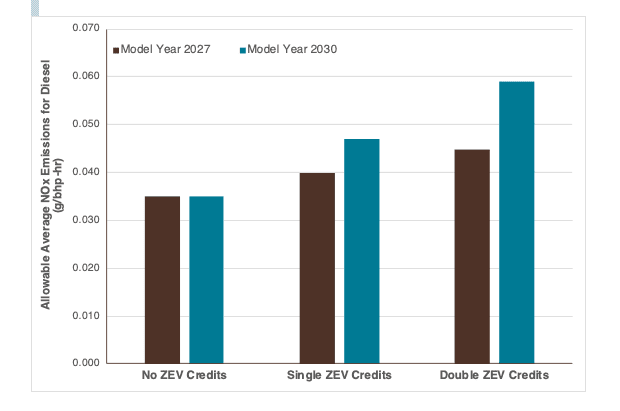Blog
Should heavy-duty vehicle manufacturers get NOx credits for ZEVs sales?
While in college, I enrolled in a physical chemistry course that was taught only at 8 am. Due to the difficult subject matter and early start time, attendance was poor, and it soon became clear that this truancy was leading to limited understanding of the subject and poor grades on homework and exams. In response, our professor started handing out 1 extra credit point per class we attended. Suddenly, attendance shot up to nearly 100%, with mixed results: some students genuinely paid attention, but others napped or played Words with Friends. Ultimately, almost everyone in the class received an A, but, at least in my case, this did not necessarily reflect a deep understanding of physical chemistry.
Incentives are powerful motivators, whether in school or in the world of vehicle emissions, as the California Air Resources Board (CARB) knows well. CARB has taken a multiprong approach to incentivizing manufacturers to transition from gasoline and diesel vehicles to zero-emission technologies that rely on batteries and fuel cells. Starting in model year 2024, they will require that a minimum percentage of HDV sales in California be zero-emission. In addition, CARB will allow manufacturers to use ZEV sales to generate “credits” for avoided nitrogen oxide (NOx) emissions. These credits can be used to offset potentially higher emissions levels from their gasoline and diesel vehicles.
While CARB’s 2024 regulation was recently finalized, regulatory action at the federal level is also anticipated in the coming months. Sources indicate that the U.S. Environmental Protection Agency (EPA) is likely to release an updated rulemaking on NOx emissions for HDVs that will go into effect in model year 2027. Like CARB, EPA could choose to incentivize ZEVs by allowing manufacturers to generate NOx credits through ZEV production. They could also find ways to incentivize ZEVs further through NOx crediting (e.g., doubling the averaging credits generated by ZEVs). While intended to incentivize ZEV production, these options run the risk of discouraging improvements in NOx emissions for traditional heavy-duty vehicles.

Figure. Allowable average NOx emissions for diesel
To illustrate the effects of NOx credits for ZEVs, consider a manufacturer that produces exactly the share of ZEVs required by CARB (15% in 2027 and 30% in 2030) and whose remaining production comes from diesel vehicles. If that manufacturer is allowed to average out NOx emissions using ZEV-generated credits, the average allowable NOx emissions for their diesel fleet would rise by more than 30% by 2030 (see “Single ZEV Credits” column in figure), limiting the efficacy of the updated emissions standards. If the manufacturer were given double the credits for each ZEV sale, the allowable emissions from diesel vehicles would increase by nearly 70% (see “Double ZEV credits” columns). In other words, a crediting policy designed to reward manufacturers for manufacturing and selling ZEVs could lead to significant backsliding on the required emission improvements from diesel vehicles. An effective transition to zero-emission vehicles requires a double focus: promotion of ZEVs, to be sure, but also continual tightening of emissions limits of ICE-powered vehicles.
Extra credit can be a powerful tool. It can encourage students (and manufacturers) to go above and beyond what they are inclined to do. But if poorly designed, incentives can backfire. When considering ZEV legislation, EPA regulators need to ensure that manufacturer incentives to transition to ZEVs don’t undermine efforts to improve diesel and gasoline emissions. Otherwise, they’re handing out A’s just for showing up to class.
